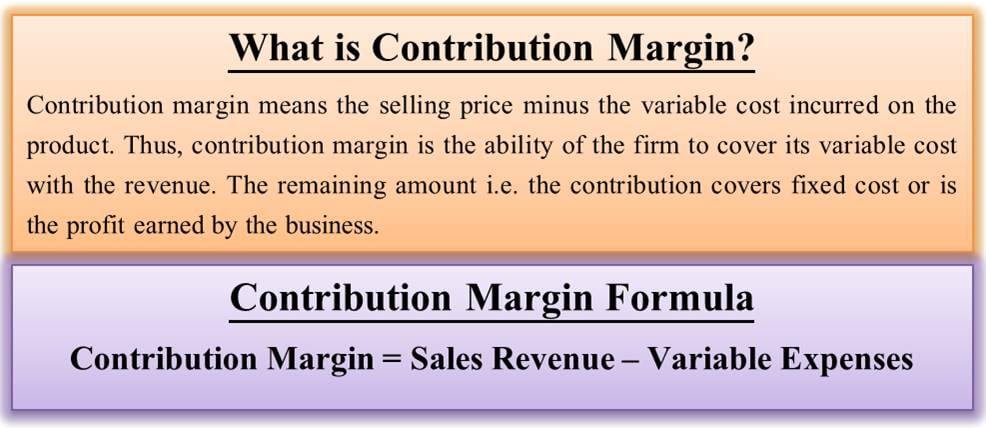Contribution Margin: Definition
In a very simple language, contribution margin means the excess of selling price over the variable cost of manufacturing. This term has two words – Contribution and Margin.
What is Contribution?
Contribution is the pool or pool of funds/revenues which is available to the entity after deducting all the variable costs for manufacture and supply of the product(s). This is the overall revenue available and is at the disposal of the entity for meeting all other fixed operating expenses and residual as profits.
Contribution Margin Ratio
When this contribution is expressed as a ratio or percentage of product price/ selling price, it is called Contribution Margin.
The availability of the contribution pool indicates that the entity is able to meet its variable costs comfortably. The higher the contribution pool, the higher the chance of breaking even and making profits. Contribution margin means the selling price minus the variable cost incurred on the product.
Thus, it is the leftover revenue after deducting the variable costs. It is the ability of the firm to cover its variable cost with the revenue.
Also Read: How to Calculate Contribution Margin?
Importance of Contribution Margin
The calculation of contribution margin is of great significance for any business for that matter. This is irrespective of the field and size of the business. It helps the business prompt a detailed cost analysis and guides the level of profitability. And whether the current contribution level is sufficient to break even, earn profits or sustain the business on a long-term basis.
Besides helping in knowing the profitability status at current price and revenue levels, it also helps in guiding and leading to many financial analyses and decisions.
- It can help to know which products are giving the highest contribution or which products the company is selling at a loss, or which product line is underperforming.
- Which process attracts the maximum costs and whether that can be outsourced to reduce the overall cost and increase the contribution to know the margins of different product lines.
- It can help evaluate whether the company should continue to manufacture or buy the product at a mid-process stage to save cost.
- This will suggest whether the extra bulk orders and at what minimum quantity and price the business should accept.
Thus, based on these analyses, after calculating and evaluating the Contribution Margin, the business can frame strategies and take necessary actions. By compiling the data, the company can increase the sales of the products that yield higher margins.
Let us now understand how to find a contribution margin.
How to Find?

The contribution margin concept gives the business the actual amount the company needs to cover its fixed costs after paying its variable cost. The formula for calculation or determining the contribution margin is as given below:
Also Read: Contribution Margin vs Gross Margin
Contribution Margin Formula
Contribution (and loosely called contribution margin) = Sales Revenue – all Variable Expenses
The formula of Contribution Margin = Contribution / Total Revenue
Expressed in Ratio (for example, 2:5) Or in percentage (for example, 40%)
OR
Contribution / Selling Price is again expressed as a ratio or percentage.
Let us take an example to better understand the contribution margin formula’s application.
Example of Contribution Margin
Suppose ABC Ltd. sells a product for $ 200. The variable cost per unit is $ 80. The variable cost per unit includes direct material expense, labor expense, and variable overhead cost. The fixed overhead cost is $ 20. Calculate the contribution margin.
In the question, the fixed overhead cost is given separately. It shall not be included in the calculation as it does not form part of the formula.
Contribution (Margin)= Sales Revenue – Variable Expenses
= $ 200 – $ 80
= $ 120
Therefore, the contribution per unit is $ 120.
Contribution Margin= Contribution / Selling Price = $120/ $200 = 60% or 3:5
You can also refer Contribution Margin vs EBITDA
Conclusion
The contribution margin is very useful for businesses. By using this formula, the business can frame its pricing policies. The actual worth of it is known when the business has a proposal, and a decision regarding its acceptance or rejection is to be made. In such a scenario, contribution margin calculation comes handy. The business can evaluate the worthiness of the proposal by looking at the contribution margin.
Using this concept, the business can give a lease of life to the business by allocating more resources towards products with a higher contribution margin per unit. Thus, it will not be wrong to say that every business uses. Instead, it must use the contribution margin formula to know the returns from different products.
Recommended Read:
- Contribution Margin Income Statement
- Operating Margin vs. Contribution Margin
- Contribution Margin vs. Gross Margin
Quiz on Contribution margin
This quiz will help you to take a quick test of what you have read here.

